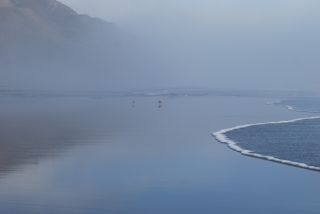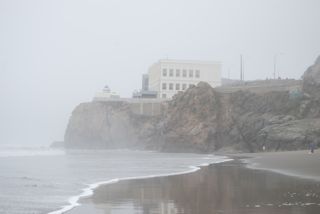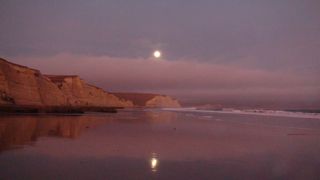 Stinson BeachAccording to the Natural Resources Defense Council’s “Losing Ground” report, climate change will have significant consequences on California’s coast. Several public agencies and other conservation designations help protect a large portion of California’s 840-mile scenic coastline. Yet rising sea levels resulting from global warming threaten to erode beaches, ravage the delicate balance of estuaries and wetlands, and destroy cultural resources and recreational areas. Point Reyes National Seashore may lose many of its estuaries; Golden Gate Recreation Area, with 59 miles of beaches, faces severe coastal flooding; and, over half of Channel Islands’ seashore has been deemed very vulnerable to rising tides.
Stinson BeachAccording to the Natural Resources Defense Council’s “Losing Ground” report, climate change will have significant consequences on California’s coast. Several public agencies and other conservation designations help protect a large portion of California’s 840-mile scenic coastline. Yet rising sea levels resulting from global warming threaten to erode beaches, ravage the delicate balance of estuaries and wetlands, and destroy cultural resources and recreational areas. Point Reyes National Seashore may lose many of its estuaries; Golden Gate Recreation Area, with 59 miles of beaches, faces severe coastal flooding; and, over half of Channel Islands’ seashore has been deemed very vulnerable to rising tides.
The report specifically names a number of beaches in Northern California, and I decided to explore these special places during my recent trip to the Bay Area. My partner on my field trip, the naturalist Jack Laws, has been exploring the California coast since childhood and made for an enthusiastic and knowledgeable tour guide.
 Red-tailed Hawk at Sunset, Point Reyes National SeashoreIn one day we managed to visit most of the beaches listed in the report, and our determination was rewarded with a trip filled with wondrous sights: from viewing ochre starfish on a rock exposed by low tide at China Beach, to observing Tule elk resting under a full moon in Point Reyes National Seashore, to gazing at harbor seals lounging in Bolinas Lagoon.
Red-tailed Hawk at Sunset, Point Reyes National SeashoreIn one day we managed to visit most of the beaches listed in the report, and our determination was rewarded with a trip filled with wondrous sights: from viewing ochre starfish on a rock exposed by low tide at China Beach, to observing Tule elk resting under a full moon in Point Reyes National Seashore, to gazing at harbor seals lounging in Bolinas Lagoon.
These magnificent places boast spectacular scenery, provide homes for diverse and numerous populations of flora and fauna, and offer recreational opportunities for people throughout the golden state. I agree with Jack, however, when he expressed his affinity for the California coast as originating from “the feeling it evoked of freedom, possibilities, and liberation in its limitless space.” For all these reasons, we simply must take action to preserve these areas before it’s too late.
Below are highlights of our field trip along with a video diary. More photos are available in my gallery.
Ocean Beach, Golden Gate Recreation Area (GGNRA): The famous Cliff House overlooks Ocean Beach; its close proximity to San Francisco makes it a popular destination for city dwellers. Even with the dense fog and cool temperatures, surfers braved the waters and beachgoers tossed frisbees. Jack discovered a red nereid worm in the sand and revived some jellyfish stranded on the low tide.
 Cliff House Overlooking Ocean BeachChina Beach, GGNRA: Named for the Chinese fisherman who camped in the sheltered cove, China Beach offers a nice picnic spot, but the swimming can be dangerous. The low tide during our visit revealed two ochre starfish clinging to a rock as they dined on mussels, and a lively gathering of seagulls on the shore included an assortment of heermann’s, mew, ring-billed, and glaucous-winged gulls. Other creatures making an appearance: a willet, shore crab, limpets, and a double-breasted cormorant.
Cliff House Overlooking Ocean BeachChina Beach, GGNRA: Named for the Chinese fisherman who camped in the sheltered cove, China Beach offers a nice picnic spot, but the swimming can be dangerous. The low tide during our visit revealed two ochre starfish clinging to a rock as they dined on mussels, and a lively gathering of seagulls on the shore included an assortment of heermann’s, mew, ring-billed, and glaucous-winged gulls. Other creatures making an appearance: a willet, shore crab, limpets, and a double-breasted cormorant.
 Golden Gate Bridge from Baker BeachBaker Beach, GGNRA: The Golden Gate Bridge, peaking out of the fog, greeted us as we entered. On the dunes of Baker Beach yellow-sand verbena and beach strawberry bloomed in bright yellow and white—a stark contrast to the dull brown sand.
Golden Gate Bridge from Baker BeachBaker Beach, GGNRA: The Golden Gate Bridge, peaking out of the fog, greeted us as we entered. On the dunes of Baker Beach yellow-sand verbena and beach strawberry bloomed in bright yellow and white—a stark contrast to the dull brown sand.
Muir Beach, GGNRA: The path to the beach leads through a brackish lagoon and we scanned the landscape for the various shorebirds that linger here. Fog hovered over the coastline, reminding me of Carl Sandburg’s famous poem: “The fog comes on little cat feet./It sits looking/over harbor and city/on silent haunches/and then moves on.” Jack told me about witnessing the spectacular salmon run on Muir Beach, while I pretended the sun was shining and waded in the water.
Stinson Beach, GGNRA: The sun strained to conquer the fog and almost succeeded, yet the marriage of light and dark painted the shore in a misty mother-of-pearl iridescence. A small willet chased a long-billed marble godwit, trying to steal his foraged food, while seagulls hosted a noisy gathering nearby. Sharks have been known to frequent the waters off Stinson beach; Jack and I searched for the telltale fin cutting through the water with no success.
Drakes Estero: Point Reyes National Seashore (PRNS): Drake’s Estero is a picturesque spot in Point Reyes National Seashore with its waters meandering gently inland; from above the waterways resemble an outstreched hand. Once a drowned river valley, the marshlands, tidal flats, seagrass beds, and intertidal areas—along with the diverse plants and animals it supports—has been recognized as one of California’s most ecologically pristine estuaries.
Point Reyes Beach, PRNS: The powerful surf and unyielding wind has shaped the character of Point Reyes beach—truly we felt like we were standing on the edge of the world. Also known as Giant Beach, the shoreline stretches undisturbed for ten miles and the water arrives unencumbered from the mighty expanse of the Pacific. Utilizing some bull kelp that had been washed ashore, Jack quickly constructed a kelp horn, although his music could hardly be heard above the roar of the wind.
 Full Moon Over Drakes BeachDrakes Beach, PRNS: Did Sir Francis Drake land at his namesake beach? There is some debate whether the sandstone cliffs along this beach refer to the white cliffs mentioned in Drake’s journal. We arrived at sunset and the pinkish hues reflected on the water while the full moon danced both in the sky and on the beach. And as if nature had cued up a delightful cast of characters for our last site, during our drive to and from Drake’s Beach we saw Tule elk resting in a meadow under a full moon, a red-tailed hawk perched on a fence post at sunset, and just before dark a great-horned owl soared past our car.
Full Moon Over Drakes BeachDrakes Beach, PRNS: Did Sir Francis Drake land at his namesake beach? There is some debate whether the sandstone cliffs along this beach refer to the white cliffs mentioned in Drake’s journal. We arrived at sunset and the pinkish hues reflected on the water while the full moon danced both in the sky and on the beach. And as if nature had cued up a delightful cast of characters for our last site, during our drive to and from Drake’s Beach we saw Tule elk resting in a meadow under a full moon, a red-tailed hawk perched on a fence post at sunset, and just before dark a great-horned owl soared past our car.
For information on the areas we toured, you can visit the National Park Service’s website on the Golden Gate National Recreation Area and Point Reyes National Seashore. The Golden Gate Conservancy and the Point Reyes National Seashore Association’s websites also contain excellent visitor information.
